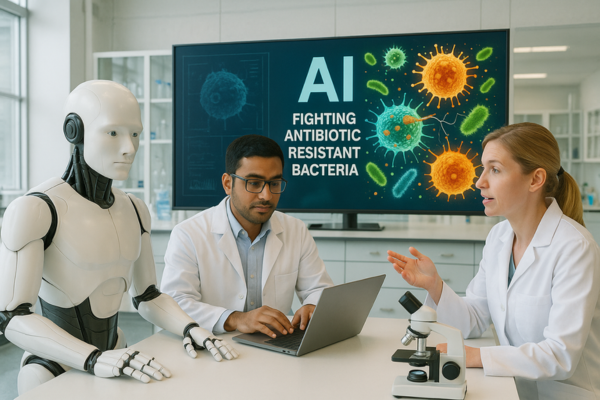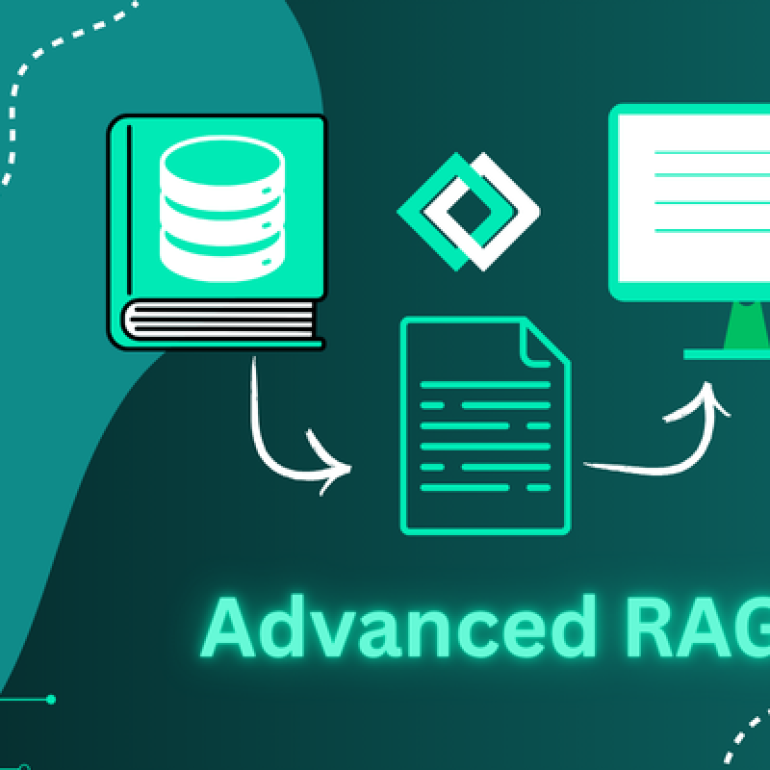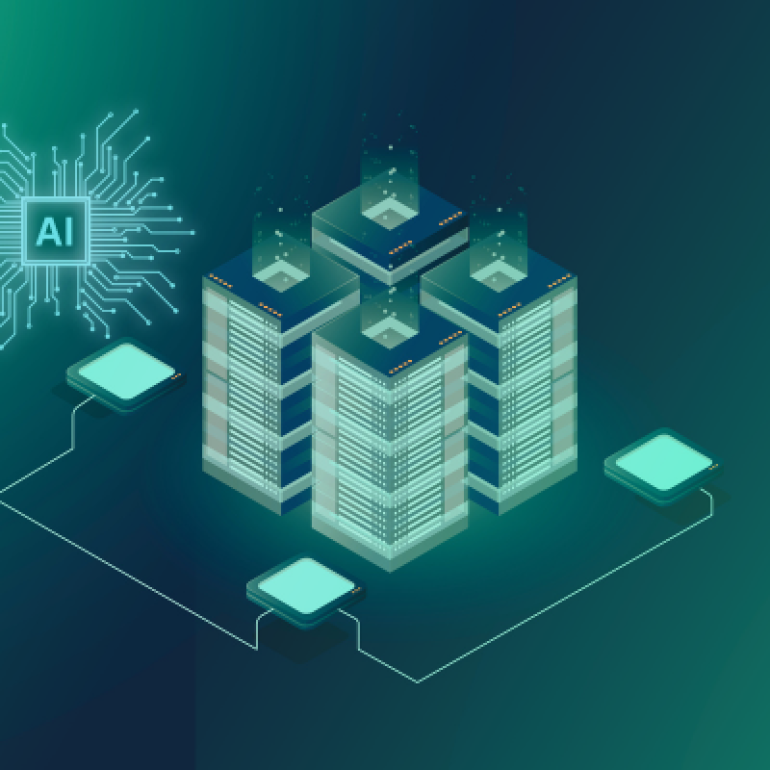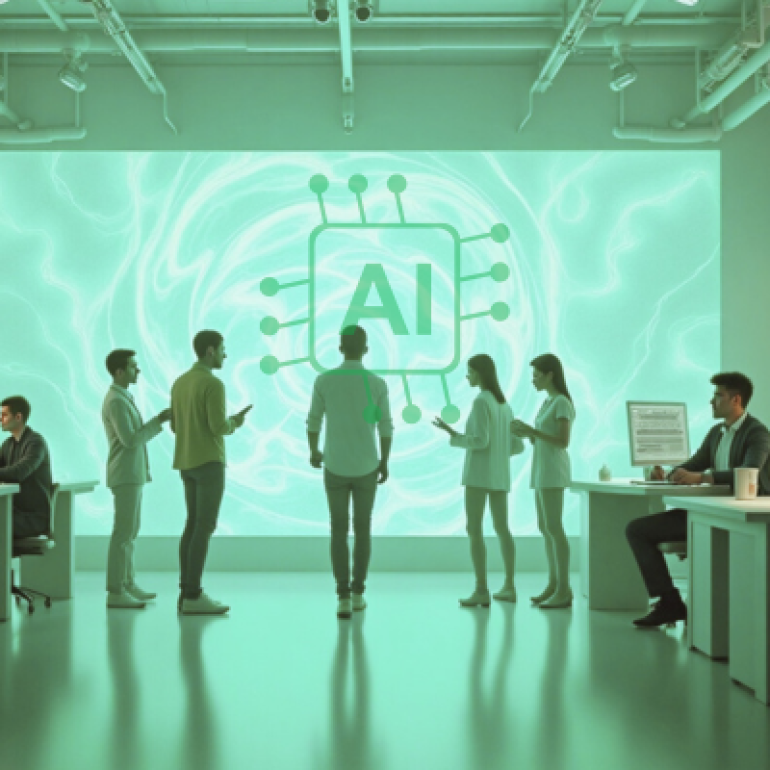- 7 July 2025
- Dr. Chandra Bondugula
Using AI to Combat Antibiotic Resistance
Antibiotic resistance is one of the most pressing global health threats, causing approximately 1.27 million deaths annually due to drug-resistant infections. With bacteria evolving to resist existing antibiotics, traditional drug development methods struggle to keep pace.

Introduction
Antibiotic resistance is one of the most pressing global health threats, causing approximately 1.27 million deaths annually due to drug-resistant infections. With bacteria evolving to resist existing antibiotics, traditional drug development methods struggle to keep pace. The World Health Organization (WHO) has declared antimicrobial resistance (AMR) a top global health concern, emphasizing the need for innovative solutions to combat this growing crisis.
Conventional drug development approaches find it difficult to keep up when germs grow to resist current antibiotics. Emphasizing the need of creative solutions to address this developing catastrophe, the World Health Organization (WHO) has identified antimicrobial resistance (AMR) as a major global health issue.
Rising as a potent weapon in the fight against antibiotic resistance, artificial intelligence (AI) is transforming drug development, illness surveillance, and individualized treatment plans. AI-driven tools can speed the discovery of novel drugs, forecast bacterial alterations, and examine large biological databases. By tackling antibiotic resistance, improving diagnosis accuracy, and streamlining treatment plans, this blog investigates how artificial intelligence is changing infectious disease care.
The Battle We Can’t Afford to Lose: Why Antibiotic Resistance Matters
The Growing Threat of Antibiotic Resistance
Antibiotic resistance is a critical global health challenge that arises when bacteria adapt and develop the ability to survive exposure to drugs designed to eliminate them. This adaptation is often a consequence of antibiotic overuse, misuse, or incomplete treatment courses, which inadvertently fosters the proliferation of drug-resistant bacteria. The implications of this resistance are significant and far-reaching:
1. Increased Mortality:
Infections that were once readily treatable may become life-threatening as available antibiotics lose their effectiveness, leading to higher mortality rates.
2. Prolonged Hospitalizations and Elevated Costs:
Treating resistant infections often necessitates longer hospital stays and the use of more complex and expensive medical interventions, driving up healthcare costs.
3. Limited Therapeutic Options:
The increasing prevalence of antibiotic resistance reduces the number of effective drugs available to combat bacterial infections, leaving clinicians with fewer treatment choices.
4. Emergence of Multidrug-Resistant Organisms:
A particularly concerning consequence is the rise of “superbugs” – bacteria that have developed resistance to multiple classes of antibiotics, posing significant treatment challenges.
The Centers for Disease Control and Prevention (CDC) estimates that antibiotic-resistant infections cause over 2.8 million illnesses and 1 tens of thousands of deaths annually in the United States alone, underscoring the severity of this issue. Given the lengthy and resource-intensive nature of traditional antibiotic drug development, innovative approaches are urgently needed. Artificial Intelligence (AI) offers a promising avenue for accelerating the discovery of new antibiotics and developing more effective strategies to combat this escalating crisis.
How AI is Transforming the Fight Against Antibiotic Resistance?
Antibiotic resistance is on the rise, which means we need new answers right away. Old ways of finding new drugs and stopping infections are slow and expensive. This means we aren’t always able to fight germs that are resistant. In this new age, artificial intelligence (AI) is changing the game by providing a multitude of ways to deal with this crisis. Big datasets, predictive analytics, and machine learning models are being used by AI in the health business to fight this problem.
1. AI-Powered Drug Discovery: Identifying New Antibiotics
AI-driven models analyze millions of chemical compounds to identify potential antibiotics in a fraction of the time required by traditional methods. Machine learning algorithms predict the effectiveness of new drugs against resistant bacterial strains, reducing costly trial-and-error processes. AI has already contributed to the discovery of new antibiotics, such as Halicin, which has shown strong efficacy against multiple drug-resistant bacteria (Nature).
2. AI in Bacterial Genome Analysis: Understanding Resistance Mechanisms
AI examines bacterial genetic sequences to detect mutations that contribute to antibiotic resistance. Machine learning can predict how bacteria will evolve in response to antibiotics, helping scientists design drugs that remain effective over time. AI-powered genomic analysis enables targeted research on bacterial vulnerabilities, leading to more effective treatment strategies.
3. AI for Personalized Antibiotic Treatments
AI analyzes patient-specific factors, such as genetics, medical history, and infection type, to determine the most effective antibiotic regimen. Predictive models optimize antibiotic dosage to minimize resistance development while maximizing treatment success. Personalized AI-driven treatments help reduce unnecessary antibiotic prescriptions, a key factor in slowing resistance buildup.
4. AI in Predicting and Controlling Antibiotic Resistance Trends
AI models track and analyze global antibiotic resistance patterns, helping public health officials anticipate emerging threats. Predictive analytics assist hospitals in implementing antibiotic stewardship programs to curb misuse. AI-powered surveillance systems monitor bacterial evolution, allowing researchers to stay ahead in the fight against superbugs.
By integrating AI into various aspects of infectious disease management, we can accelerate the fight against antibiotic resistance. AI-driven advancements in drug discovery, bacterial genome analysis, personalized treatments, and resistance prediction are paving the way for more effective, efficient, and targeted approaches to combating this growing health crisis.
Can AI Improve the Diagnosis of Antibiotic-Resistant Infections?
1. AI-Powered Diagnostic Tools for Faster Detection
AI-enhanced diagnostic tools can quickly and accurately identify antibiotic-resistant infections by analyzing complex medical data, including medical images (like X-rays and CT scans showing infection) and laboratory results (like blood cultures and genetic sequencing data). Diagnoses are much faster with this capability than with manual analysis. AI-powered fast testing analyzes patient samples’ molecular or proteomic signatures using machine learning. This allows drug-resistant bacterium detection and resistance mechanism identification in hours, a huge advance over culture-based approaches that can take days. AI-driven diagnostic solutions use several data streams and advanced algorithms to detect and differentiate bacterial infections. This prevents misdiagnoses, delays treatment, and antibiotic misuse that can increase resistance.
2. AI in Electronic Health Records (EHR) for Resistance Tracking
AI effortlessly connects with EHR systems to continually monitor and evaluate a patient’s infection history, including past illnesses, treatments, and antibiotic use. This shows individual antibiotic resistance risk variables holistically. AI-driven data analytics can analyze massive volumes of anonymised patient data from EHR systems to uncover antibiotic resistance trends across local, regional, and national populations. This illuminates resistance spread and guides public health measures. Predictive models combining AI algorithms and EHR data can identify individuals at high risk of antibiotic-resistant illnesses or first-line treatment resistance. This lets doctors adopt tailored antibiotic stewardship programs, optimize treatment decisions from the start, and prevent resistance.
AI in Global Surveillance of Antibiotic Resistance
I. AI for Real-Time Outbreak Monitoring
- AI-powered surveillance systems track bacterial resistance patterns worldwide.
- Machine learning models predict outbreaks of drug-resistant infections before they spread.
- AI-driven epidemiological research assists governments and healthcare organizations in proactive decision-making.
II. AI in Public Health Policy and Antibiotic Stewardship
- AI provides data-driven insights to guide public health policies on antibiotic usage.
- AI helps develop guidelines for appropriate antibiotic prescribing practices.
- AI-powered predictive models assess the impact of policy changes on resistance trends.
Challenges and Ethical Considerations of AI in Antibiotic Resistance
I. Data Limitations and Bias in AI Models
- AI models require high-quality, diverse datasets to produce accurate predictions.
- Bias in training data can lead to inaccurate resistance predictions, affecting treatment decisions.
- Continuous updates and diverse data integration are essential for AI reliability.
II. Ethical Concerns in AI-Driven Healthcare
- AI algorithms should complement, not replace, human medical expertise.
- Transparency in AI decision-making is crucial to maintaining patient trust.
- Ethical guidelines must be established to ensure responsible AI implementation in healthcare.
III. Cost and Accessibility Barriers
- High implementation costs may limit AI adoption in low-resource healthcare settings.
- AI-driven diagnostic tools must be scalable and affordable for global use.
- Public-private partnerships can help expand AI accessibility in healthcare.
What is the future of AI in combating Antibiotic resistance?
1. AI-Driven Precision Medicine for Infection Control
AI will become increasingly important in the future in allowing highly customized, real-time therapy recommendations for diseases. AI algorithms will direct doctors towards the most appropriate antibiotic for that particular patient at that exact moment by examining their distinctive genetic makeup, illness features, and treatment history.
Driven by artificial intelligence, advanced predictive analytics will transcend basic sensitivity testing. These models will maximize antibiotic selection not only depending on present resistance profiles but also by estimating the probability of treatment success and possible side effects, hence guiding more sensible and efficient antibiotic use. Moreover, artificial intelligence will maximize efficacy by adjusting antibiotic dosages depending on individual patient characteristics, therefore reducing the selective pressure that can propel the emergence of new resistance.
By encouraging focused and effective treatments, lowering broad-spectrum antibiotic use, and optimizing dosages to eradicate infections entirely and prevent the selection of resistant mutants, AI-assisted precision medicine will ultimately greatly minimize the risk of developing new antibiotic resistance strains.
2. AI in Next-Generation Antibiotic Development
In silico simulations driven by artificial intelligence and machine learning algorithms will transform drug design and development procedures. AI can find fresh drug candidates with more efficiency and less expense than conventional approaches by means of analysis of large databases of chemical structures, bacterial targets, and drug interactions. This covers the design of compounds able to target fresh bacterial routes or overcome current resistance mechanisms.
Predicting bacterial evolution and the development of new resistance mechanisms going forward will depend critically on artificial intelligence models. AI can predict how bacteria can adapt to both current and new antibiotics by examining genetic and proteomic data, therefore enabling researchers to proactively create medications less prone to future resistance.
Rising cooperation among artificial intelligence researchers, microbiologists, and pharmaceutical corporations will define antibiotic development going forward. Accelerating target selection, drug design, and preclinical testing using artificial intelligence will be crucial in closing the present gap in antibiotic development and enabling more quickly available new treatments.
3. AI’s Role in Global Healthcare Equity
Mobile health apps driven by artificial intelligence will enable people and healthcare professionals in underprivileged areas with means for improved infectious disease control. By helping early symptom identification, offering advice on cleanliness and infection control, and maybe linking patients with distant diagnostic and treatment providers, these apps can help to improve access to timely care.
Telemedicine systems driven by artificial intelligence will increase access to specialized antibiotic resistance diagnostics and expert consultation over national boundaries. Remotely evaluating diagnostic data, guiding treatment decisions, and enabling communication between healthcare personnel in resource-limited environments and experts globally—AI can help.
Models of machine learning will help healthcare systems maximize global resource allocation for worldwide infection control. AI can help identify areas of most need, predict outbreaks, and guide the strategic deployment of diagnostic tools, antibiotics, and personnel to effectively combat resistance in resource-limited environments, so contributing to greater global healthcare equity by means of analysis of epidemiological data, resistance patterns, and healthcare infrastructure.
Conclusion
AI is revolutionizing the fight against antibiotic resistance by accelerating drug discovery, enhancing diagnostics, and improving global surveillance. With AI-powered tools, healthcare providers can predict, prevent, and combat resistant infections more effectively. While challenges such as data bias, ethical concerns, and accessibility remain, ongoing advancements in AI promise a future where antibiotic resistance is no longer an insurmountable threat. By integrating AI into infectious disease treatment, we can usher in a new era of precision medicine and global health security.




